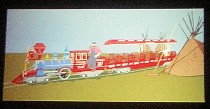
Roberta and I got a little preview of Eamon Ore-Giron’s show that will open tomorrow (Friday) night at the Pennsylvania Academy of Fine Art. We had just sat through a talk of his–one of those swell slide lectures by artists that I’ve been going to religiously because they’ve been pretty interesting. Curator Alex Baker invited us into the gallery for a peek (the images are from the slides at the talk and not from the show, and they’re blurry enough for me to apologize; this work is hard-edged and intense).
ore-giron, eamon
Unlike Roberta, I had missed Ore-Giron’s show at Gallery 222 (here’s Roberta’s post on it), and so had no sense of scale beyond the little 2″ on-line pictures we run and the slides for the talk. The scale shocked me–these are big paintings with enormous presence, spaces that physically pull you in. The new work is beautiful–and totally trippy, with Pop colors and pattern inspirations stolen from all over the place–even mehndi henna decoration, which Baker said was something Ore-Giron did for money for a while.
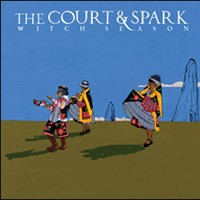 The show includes a wall installation with vinyl records that have been decorated with stenciled and etched patterns and Roberta said she wondered if Ore-Giron had been a DJ. Poking around the web I found a link to a page with his fave music as well as links to two albums for which he did the covers (image left).
The show includes a wall installation with vinyl records that have been decorated with stenciled and etched patterns and Roberta said she wondered if Ore-Giron had been a DJ. Poking around the web I found a link to a page with his fave music as well as links to two albums for which he did the covers (image left).
Here’s a smattering of more background info: Ore-Giron had a residency at Headlands last year and exhibitions include “Bay Area Now 3” Yerba Buena Center for the Arts in San Francisco, “Widely Unknown” at Deitch Projects in New York, and a show at White Box also in New York.
This is a guy who is into popular culture–and its limits.
His name is sort of a clue to some of what he’s about. His mom is from a long-time Arizona family of Irish descent, hence the first name. His dad is Peruvian, hence the last name, and Ore spent many summers visiting family in Peru. And the land he paints, he has named Arizonia.
That crossing of borders both at home and abroad and then living just north of the Mexican border all became fodder for his visions (speaking of visions, he did mention Carlos Castaneda, and Alex Baker mentioned peyote-inspired Huichol art). He’s also been looking at advertising and publications and whatever is part of the culture at this point in time).
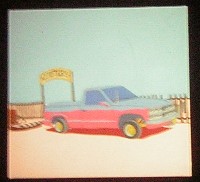 Listening to Ore-Giron is a reminder that he’s from the Four Corners area, the real Arizona. His ideas live somewhere in the spaces between his words. Unlike us East Coast intellectuals, he has a level on which he communicates that belongs in the land of dreams, where words neither delimit nor create the concepts. Sound bites are not part of the delivery. And big skies, intensely blue, are only rarely not a part of the imagery (right, the pickup here picks up the sky and the pink earth).
Listening to Ore-Giron is a reminder that he’s from the Four Corners area, the real Arizona. His ideas live somewhere in the spaces between his words. Unlike us East Coast intellectuals, he has a level on which he communicates that belongs in the land of dreams, where words neither delimit nor create the concepts. Sound bites are not part of the delivery. And big skies, intensely blue, are only rarely not a part of the imagery (right, the pickup here picks up the sky and the pink earth).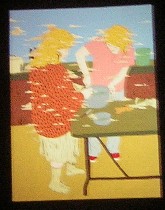 Like his ideas, his experience bridges spaces. He spent six months in Peru teaching English. While down there, he worked with an artist who was into “in-depth patterning. …Each little spill of paint fitted with the characters.” The bright colors have affected Ore’s recent use of color. Ore said on his return to American culture he saw things differently (left, his aunt and cousin making tamales; the sky has dipped down, clouds punctuating the workers; the paintings, which used to have cartoony outlines, are now more painterly).
Like his ideas, his experience bridges spaces. He spent six months in Peru teaching English. While down there, he worked with an artist who was into “in-depth patterning. …Each little spill of paint fitted with the characters.” The bright colors have affected Ore’s recent use of color. Ore said on his return to American culture he saw things differently (left, his aunt and cousin making tamales; the sky has dipped down, clouds punctuating the workers; the paintings, which used to have cartoony outlines, are now more painterly).Earlier influences include San Francisco Bay area conceptualists. He mentioned Paul McCarthy a couple of times. Ore-Giron, who went to the San Francisco Art Institute, is now studying at UCLA and felt he had to defend his return to school, which gives him a lifestyle in which he can really focus on his art.
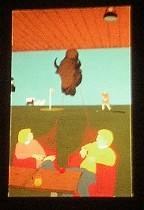 Ore-Giron started his talk by showing a series of paintings of an all-you-can-eat cafeteria in Flagstaff, which he said was full of animals watching while you ate (I’m presuming game trophies on the wall, but I’m not really sure). He ratcheted up the weirdness when he added a golf course to represent disrespect of local natural terrain. The golf course has become a repeating metaphor in his work for any number of things about the culture, including a game–again not real life and real life all at once (right, one of the all-you-can-eat cafeteria paintings).
Ore-Giron started his talk by showing a series of paintings of an all-you-can-eat cafeteria in Flagstaff, which he said was full of animals watching while you ate (I’m presuming game trophies on the wall, but I’m not really sure). He ratcheted up the weirdness when he added a golf course to represent disrespect of local natural terrain. The golf course has become a repeating metaphor in his work for any number of things about the culture, including a game–again not real life and real life all at once (right, one of the all-you-can-eat cafeteria paintings). Ore-Giron said he took a four-year hiatus from the art he was doing as an undergraduate. Painting, he said, was narcissistic, and he needed to get away. “I came back with a new sensibility from not being involved [in painting] for a while and not fixating.”
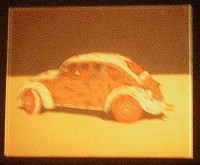 When he started painting wood-grain patterns, the grain “became a section [in each painting] that I could let my inner tripper out,” he said. “It kind of became skin. The wood was alive.” The pattern-making was also a way of marking time (left, a wood-patterned VW; it’s alive).
When he started painting wood-grain patterns, the grain “became a section [in each painting] that I could let my inner tripper out,” he said. “It kind of became skin. The wood was alive.” The pattern-making was also a way of marking time (left, a wood-patterned VW; it’s alive).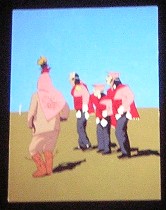 Talking about the paintings he did of dancers, which have a de Chirico empty plaza with long-shadows ambiance, he said he was interested in the crossing of cultures. The Peruvian dancers on masks to resemble and mock white people. “There’s something really creepy about it as well as with masks.” Underneath the white masks are native people and native culture. He was interested in what it is to wear a mask–again thinking about the spaces between realities (right, one of the Peruvian-dancer paintings).
Talking about the paintings he did of dancers, which have a de Chirico empty plaza with long-shadows ambiance, he said he was interested in the crossing of cultures. The Peruvian dancers on masks to resemble and mock white people. “There’s something really creepy about it as well as with masks.” Underneath the white masks are native people and native culture. He was interested in what it is to wear a mask–again thinking about the spaces between realities (right, one of the Peruvian-dancer paintings).But he’s also thinking about archetypal meanings: “I love how the physicalness of dancing combines with the music. It’s like those patterns have always existed.”
Since the empty spaces of the dance paintings, he said his work has gotten more elaborate with more patterning and minutiae.
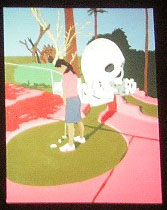 The golf course and the cafeteria animals have popped up again in his more recent miniature golf paintings, with their pychedelic surroundings and colors. And the animals from the cafeteria paintings have a satirical new life as obstacles and decorations (left, Ore-Giron’s wife playing miniature golf).
The golf course and the cafeteria animals have popped up again in his more recent miniature golf paintings, with their pychedelic surroundings and colors. And the animals from the cafeteria paintings have a satirical new life as obstacles and decorations (left, Ore-Giron’s wife playing miniature golf).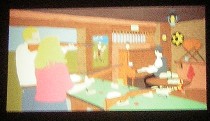 He’s also interested in the way we transform the past, turning it into an ideal environment. The example he showed was of a replica of the Old West, a shooting gallery in Tucson with theatrical shootouts, a sort of dreamland of “history” (right). He contrasted that idealization with the chaotic image of the Western past in “Blood Meridian” by Cormac McCarthy.
He’s also interested in the way we transform the past, turning it into an ideal environment. The example he showed was of a replica of the Old West, a shooting gallery in Tucson with theatrical shootouts, a sort of dreamland of “history” (right). He contrasted that idealization with the chaotic image of the Western past in “Blood Meridian” by Cormac McCarthy.
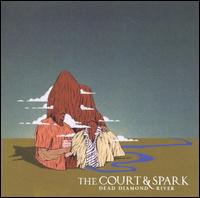 He said he’s looking at things with a sense of humor and a graphic, illustrative quality, as in “Bro’ Mountain,” for which I am using the record album version of the image. He’s interested in the attention paid to monument-like natural objects. He said the simplicity of the design and placement of the mountain was similar to Japanese Shintoism and the significance of where an object is placed. The transformational bodies emerging remind me of how people see an image of the Virgin Mary in shape of a french fry and then worship it.
He said he’s looking at things with a sense of humor and a graphic, illustrative quality, as in “Bro’ Mountain,” for which I am using the record album version of the image. He’s interested in the attention paid to monument-like natural objects. He said the simplicity of the design and placement of the mountain was similar to Japanese Shintoism and the significance of where an object is placed. The transformational bodies emerging remind me of how people see an image of the Virgin Mary in shape of a french fry and then worship it.
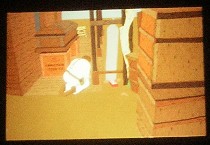 “It’s important to me to feel contemporary, to tread on ground that hasn’t been tread it. And it’s important it speaks from somewhere inside.”
“It’s important to me to feel contemporary, to tread on ground that hasn’t been tread it. And it’s important it speaks from somewhere inside.”
At the same time, he edits his ideas and asks himself of each painting: “This is important to me, but why would it be important to anyone?” That self-editing results in a body of work that’s relatively easy to access, with its Pop vocabulary and representational Surrealism and humor. Nonetheless, there’s plenty there to chew on.









